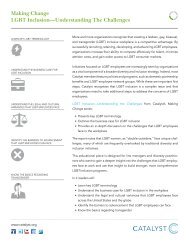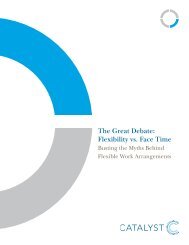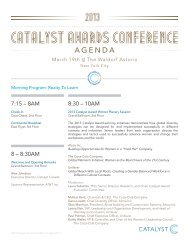ENgAgiNg MEN iN gENdEr iNiTiATivEs - Catalyst
ENgAgiNg MEN iN gENdEr iNiTiATivEs - Catalyst
ENgAgiNg MEN iN gENdEr iNiTiATivEs - Catalyst
- No tags were found...
You also want an ePaper? Increase the reach of your titles
YUMPU automatically turns print PDFs into web optimized ePapers that Google loves.
63 We conducted thematic analysis of these interviews toidentify these perceived barriers.64 In the Spring of 2007, popular radio personalityDon Imus was suspended and subsequently firedafter using racial and sexist slurs when referring tomembers of the successful and primarily African-American Rutgers women’s basketball team. For asummary of these events, see Bill Carter and JacquesSteinberg, “Off the Air: The Light Goes Out for DonImus,” The New York Times (April 13, 2007), http://www.nytimes.com/2007/04/13/business/13imus.html?_r=1&oref=slogin.65 Michael Welp, “Vanilla Voices: Researching WhiteMen’s Diversity Learning Journeys,” AmericanBehavioral Scientist, vol. 45, no. 8 (April 2002): p.1,288-1,296.66 Blader and Tyler.67 Ham and van den Bos.68 Bob Pease, “(Re)Constructing Men’s Interests,” Menand Masculinities, vol. 5, no. 2 (October 2002): p. 165-177.69 These costs and benefits are discussed in the followingreferences: Pease; R. W. Connell, “The Role of Men andBoys in Achieving Gender Equality” (paper presentedat the United Nations, Division for the Advancement ofWomen in collaboration with the International LabourOrganization, Brasilia, Brazil, October 21-24, 2003),http://www.un.org/womenwatch/daw/egm/menboys2003/Connell-bp.pdf.70 Richard P. Eibach and Thomas Keegan, “Free atLast? Social Dominance, Loss Aversion, and Whiteand Black Americans’ Differing Assessments ofRacial Progress,” Journal of Personality and SocialPsychology, vol. 90, no. 3 (March 2006): p. 453-467.71 See page 14.72 Janet K. Swim, Kathryn J. Aikin, Wayne S. Hall,and Barbara A. Hunter, “Sexism and Racism: Old-Fashioned and Modern Prejudices,” Journal ofPersonality and Social Psychology, vol. 68, no. 2(February 1995): p. 199-214.73 Leo Montada and Angela Schneider, “Justice andEmotional Reactions to the Disadvantaged,” SocialJustice Research, vol. 3, no. 4 (December 1989): p.313-344.74 Mahalik et al., “Development of the Conformity toMasculine Norms Inventory.”75 Survey responses were submitted to an exploratoryfactor analysis using a maximum likelihood extractionmethod and promax rotation. Examination of theresulting scree plot indicated that a 3-factor solutionfit the data. Goodness of fit statistics also indicatedthat a 3-factor solution was adequate (χ 2 =692.51, df=592, p.05.77 A chi-square statistic cannot be computed in this case,since the variable is a constant (i.e., the total numberof respondents in this category equals the numberfrom the comparison group).78 χ 2 =2.91, p.05.81 χ 2 =1.10, p>.05.82 The percentages do not add up to 100 percent sinceonly the industries with the highest representation areshown here.83 χ 2 =1.49, p>.05.84 χ 2 =.90, p>.05.85 χ 2 =1.80, p>.05.86 χ 2 =.33, p>.0587 David Dunning, Chip Heath, and Jerry M. Suls, “FlawedSelf-Assessment: Implications for Health, Education,and the Workplace,” Psychological Science in thePublic Interest, vol. 5, no. 3 (December 2004): p. 69-106.88 χ 2 =3.74, p=.0534 | Engaging Men in Gender Initiatives













